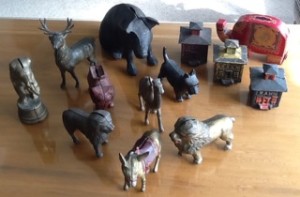
The Lopez Island Library invites you to share the pure joy of Gale McCallum’s remarkable collection of antique penny banks. Saving coins in some type of receptacle is probably as old as the advent of the use of coins. The oldest known money box was found in a Greek colony dating to 2nd century BCE. Originally these containers were called money boxes but by the 18th century they were known as piggy banks. In Scotland any money box is called a pirly pig. One theory for the use of the pig as symbol is that in earlier times the pig was a valuable commodity and therefore considered a good luck charm. Whatever the history, piggy banks have long been given to children to encourage thrift.
Saving banks originally were made of pottery or porcelain which had to be broken to retrieve the coins. The banks in this collection are primarily made of cast iron or tin with a few made of pottery, leather, glass, and wood. The cast iron banks are opened by a screw holding the two sides together, while the tin usually are opened with a key.
The majority of the banks in this collection are American and English. There are a few from other countries including: Ireland, Denmark, Mexico and Argentina. Many of the cast iron banks were manufactured by J. Chein & Co of Burlington, New Jersey from 1900. Another company well known for their still and mechanical banks was J&E Stevens who began manufacturing them in the 1850’s.
THE WISE PIG a poem that appeared on a cast iron bank at the end of the 19th century
Save a penny yesterday
Another save today
Tomorrow save another
To keep the wolf away
Benjamin Franklin’s POOR RICHARD’S ALMANAC:
God helps them that help themselves
If you would be wealthy, think of saving
As well as getting.
A penny saved is two pence clear.
Motto from Tin Still Bank circa 1925:
If you get and spend a penny
Then, of course you haven’t any.
Little children work and play
And save your pennies every day.